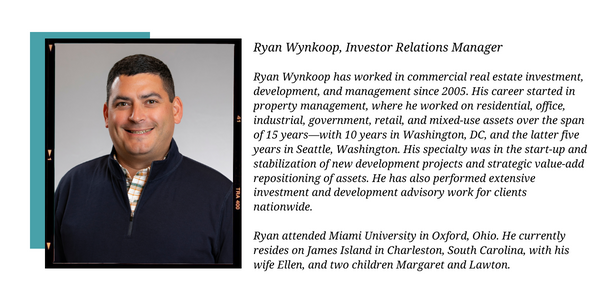October 26, 2023
By: Ryan Wynkoop, Investor Relations Manager

Understanding the Underwriting Process is a Valuable Part of Your Due Diligence
Underwriting plays a pivotal role in syndication investments, and it is crucial for investors to understand and conduct thorough due diligence.
By definition, underwriting refers to the process of evaluating and assessing the financial risks or potential returns of an investment opportunity.
Underwriting of syndication investments allows investors to make informed decisions based on a comprehensive analysis of the property’s financial performance.
Financial Metrics That Set You Up for Success
Through underwriting, investors can assess various financial metrics such as cash flow, net operating income, and return on investment.
By thoroughly evaluating these factors, investors can determine the viability of the investment and make informed decisions about whether the potential returns align with their investment goals and risk tolerance.
Identify Red Flags Before It’s Too Late
Additionally, underwriting enables investors to identify potential red flags or risks associated with the investment opportunity. Investors can spot discrepancies, potential vacancies, or operational inefficiencies by analyzing the property’s income and expense statements, rent rolls, and market data.
These insights allow investors to mitigate risks and adjust their investment strategy . Additionally, they allow investors to align a potential investment with their risk tolerance.
Underwriting also helps investors to negotiate and structure the syndication deal.
Armed with a detailed analysis of the investment, investors can confidently negotiate the terms of the deal, ensuring that the investment aligns with their objectives and offers favorable returns.
Through underwriting, investors can also identify potential value-add opportunities and propose strategies to maximize performance and increase the property’s value over time.
By conducting due diligence and evaluating the financial aspects of the opportunity, investors can reduce risks, maximize returns, and strategically position themselves for long-term success in the world of syndication investments.
So, let’s dive deep into the math that makes up investment underwriting.
Step 1: Start with the Basics
The first thing that we need to know is how many units make up a particular property. For this example, let’s consider investing in a 400-unit multifamily syndication. Additionally, we need to know what the current in-place rents are to calculate the gross potential income.
Unit Count: Begin by noting the number of units in the property, which is 400 units.
In-Place Average Rents: Typically found in the investment presentation, let’s assume the in-place average rents are $2,000 per unit per month.
Calculate Gross Potential Income: Multiply the unit count (400) by the average rent ($2,000) to get $800,000.
In the real estate industry, many aspects operate within a one-year time frame. This might include a one-year lease or analyzing a trailing 12 statement, which reflects the previous 12 months of income and expenses for a property. So, let’s get to an annualized figure.
Annualize the Income: Multiply this monthly income by 12 to calculate the annual potential income, which equals $9,600,000.
This assumes every unit was occupied and each tenant paid rent consistently for a full 12-month period, which usually isn’t the case. Therefore, we must determine the vacancy rate specifically for this property.
Step 2: Account for Vacancy
To calculate the vacancy rate for this specific property, as a reference point, let’s consider the national average, which currently stands at 93% occupancy. This implies that 7% of the units are either not collecting rent or are currently unavailable for renting.
Adjust for Vacancy: Multiply the annual potential income ($9,600,000) by 0.93 to account for the 7% vacancy rate. This gives us $8,928,000.
Include Other Income Sources
Our next step is to determine the other sources of income generated by this property.
This may include income from pet deposits, application fees, valet trash, and even covered car parking or reimbursed utilities.
The list of potential income sources is extensive, and multifamily properties typically have more diverse sources of income than merely rent from residents. In this case, let’s assume these sources contribute an extra 5% to the annual income.
Add Other Income: Multiply $8,928,000 by 1.05 to include the additional income sources, resulting in $9,374,400. This is the total annual income.
Step 3: Expenses and NOI
Net operating income (NOI) is a critical measure in commercial real estate as it indicates the profitability of a property before considering the impact of factors such as taxes and financing. It serves as the foundation for determining the value of a property and plays a vital role in investment and financing decisions.
Every property and every market will differ, but let’s assume this deal incurs 40% in expenses. This means that 60% of the total revenue is profit.
Calculate NOI: Multiply the total income ($9,374,400) by 0.60 to get the Net Operating Income (NOI), which is $5,624,640.
Step 4: Cap Rate and Property Value
Cap rate and property value are crucial factors in commercial real estate as they provide key insights for investors and buyers.
The cap rate, or capitalization rate, helps determine the expected return on investment by comparing the net operating income with the property’s value. This information allows investors to assess the profitability and attractiveness of a commercial property.
On the other hand, property value is essential for determining a property’s worth and guides pricing decisions, financing options, and overall investment strategy.
Understanding the relationship between cap rate and property value is vital for successful investment decisions in the commercial real estate market.
The NOI can be divided by the cap rate specific to the deal, which varies according to the market.
The cap rate is typically available in the investment presentation. For the sake of simplicity, let’s consider a 5% cap rate.
How to Determine Property Value: Divide the NOI ($5,624,640) by the cap rate (5%) to calculate the property’s value, which equals $112,492,800 in this example.
How to Determine the Cost Per Unit: Divide the property value ($112,492,800) by the number of units (400) to get $281,232 per unit.
To determine the value of this property, it is essential to have information regarding the number of units, current rents, and occupancy rate.
These figures, when multiplied by 12 to annualize them, along with the expense ratio, cap rate, and net operating income (NOI), can be utilized in a straightforward calculation that will provide the property’s value.
How Do You Know if Syndications are Right for You?
Developing a solid understanding of underwriting is vital for investors considering syndications.
Although the GP or underwriting/acquisitions team typically handles the detailed analysis, investors can still gain valuable insight by reviewing that analysis in their own due diligence process.
LPs can make more educated investment decisions by understanding how deals are underwritten and how value is determined in large properties.
This knowledge enables them to evaluate the profitability and desirability of a commercial property, thus enhancing their overall investment knowledge.
If you would like to learn more about investing in syndications, visit https://info.ashcroftcapital.com/fund, or schedule a call with our Investor Relations Team.



